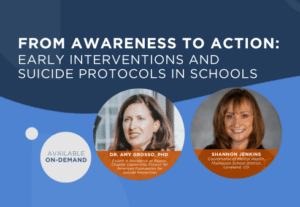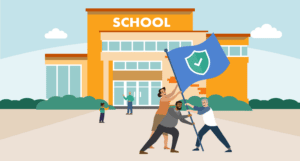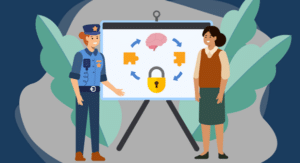Listen to this blog
4 minutes
By: Dr. Amy Grosso
Traditionally, when we talk about suicide prevention in schools, the conversation often centers on crisis plans—those immediate interventions designed to respond when a student is in extremely noticeable distress. While such measures are undoubtedly vital, they represent just one facet of a comprehensive approach to suicide prevention.
The Limitation of Crisis-only Focus
Focusing exclusively on the immediate crisis is akin to putting fires out without ever investigating how the fire started in the first place. Relying solely on crisis response strategies may overlook early warning signs or fail to foster an environment that encourages students to speak up about their struggles. Addressing suicide prevention holistically, therefore, requires an understanding and appreciation of its broader aspects.
Expanding the Definition of Suicide Prevention
To truly make strides in suicide prevention, schools must create cultures where every student feels safe, valued, and understood. This means moving beyond just crisis plans. How?
- Culture of Safety: Establishing an environment where students can openly discuss their feelings and concerns without fear of judgment is pivotal. This means both physical safety and psychological safety.
- Integrating Coping Strategies: By incorporating coping strategies into the curriculum, schools arm students with tools they can use when faced with stress, anxiety, or depression. Equip them not just with academic knowledge, but also with life skills to manage emotional challenges.
- Promotion and Awareness: Events like Suicide Prevention Month play a critical role. By dedicating time to openly discuss, educate, and spread awareness, schools send a strong message: the well-being of students is a top priority.
- Holistic Care: Caring about students extends far beyond their academic performance. Schools must consider their emotional, psychological, and social well-being. Recognizing the importance of these facets and addressing them can significantly bolster suicide prevention efforts.
- Collaboration with Families: Any suicide prevention work must extend beyond the school day. Offering information sessions on what is being taught in school, such as coping strategies or information provided during Suicide Prevention Month, will assist families in reinforcing skills at home.
The Role of School Environment
Central to expanding the definition of suicide prevention is the school’s environment. An empathy-driven culture—one where every staff member from teachers to administrators prioritizes understanding and support—can transform the school experience for many students.
Consider the scenario where a teacher notices a change in a student’s demeanor over several classes. The teacher’s concern shouldn’t be solely about grades but about the student’s overall well-being. By creating space for non-academic conversations, the school opens doors for students to share, seek help, or simply feel seen and understood.
Furthermore, leadership plays a pivotal role. School administrators should encourage and provide training for their staff to recognize warning signs and facilitate open conversations. Regular mental health training sessions and collaborations with local mental health providers can go a long way in ensuring staff are well-equipped to handle sensitive situations.
Ultimately, by cultivating a supportive, empathy-driven culture, schools can shift their approach from simply reacting to crises to proactively preventing them. Such an environment not only detects and addresses concerns early but also reduces the chances of these concerns escalating.
Intervene Earlier with Raptor
For too long, the conversation around suicide prevention in schools has been limited to crisis response. While these interventions are essential, they are just the tip of the iceberg. To genuinely make a lasting difference, schools must recognize and act upon the broader aspects of suicide prevention.
From creating safe spaces for open dialogue to integrating coping strategies in the curriculum and fostering an empathy-driven culture, there’s much that can be done. Schools hold the power to redefine the narrative around student wellbeing, ensuring that each student feels valued, understood, and supported. Only by embracing this holistic approach can we hope to make significant strides in suicide prevention.
Raptor can help. Learn how in our free Guide to K-12 Student Wellbeing.
For more resources:
There are many resources available to provide suicide prevention support. Here are seven great options to consider if you or someone you know needs help.
- 988 –The 988 Suicide & Crisis Lifeline is a national network of local crisis centers that provides free and confidential emotional support to people in suicidal crisis or emotional distress 24 hours a day, 7 days a week in the United States.
- Model School District Policy on Suicide Prevention – The Model School District Policy on Suicide Prevention gives educators and school administrators a comprehensive way to implement suicide prevention policies in their local community. It was developed by the American Foundation for Suicide Prevention, the American School Counselor Association, the National Association of School Psychologists, and The Trevor Project, the program is research-based and easily adaptable for middle and high schools.
- After a Suicide: A Toolkit for Schools – In collaboration with the Suicide Prevention Resource Center, AFSP offers After a Suicide: A Toolkit for Schools to help schools respond in the aftermath of a suicide death.
- American Foundation for Suicide Prevention – AFSP offers a variety of programming on suicide prevention for staff, students, and families.
- National Alliance on Mental Illness – NAMI offers a wide variety of programming for students and families on a variety of mental health topics.
- The Jason Foundation – The Jason Foundation focuses on youth suicide and offers training for students, parents, educators, coaches, and youth workers.
- The Jed Foundation – The Jed Foundation is a nonprofit that protects emotional health and prevents suicide for our nation’s teens and young adults, giving them the skills and support they need to thrive today… and tomorrow. The website has a resource center.

Dr. Amy Grosso
After completing her Ph.D. in Counseling and Counselor Education at The University of North Carolina at Greensboro, Dr. Amy Grosso began her career as a mental health counselor at Wake Forest Baptist Health. After accepting her position as the Director of Behavioral Health at Round Rock ISD, Dr. Amy’s accomplishments include:
- Creating the Behavioral Health Services Department, including the hiring and oversight of a team of social workers—and the first-ever social worker dedicated to supporting staff.
- Assisting the establishment of the Round Rock ISD Police Department and specifically designing how social workers work in conjunction with police officers.
- Overseeing the implementation of threat assessment and comprehensive suicide protocols.
Dr. Amy serves on the National Chapter Leadership Council of American Foundation for Suicide Prevention. She co-authored the book Schoolwide Collaboration for Transformative Social Emotional Learning, August 2021.
Related Resources
Guide to K-12 Student Wellbeing
Strategies to Recognize, Document, and Support Students in Distress
Listen to this blog
4 minutes








